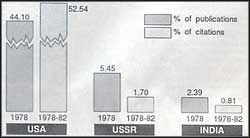Mere volume will not sell research papers abroad
 INDIAN scientists rank among the 10 most prolific producers of scientific papers in the world; yet their research is among the least cited in international scientific and technological literature.
INDIAN scientists rank among the 10 most prolific producers of scientific papers in the world; yet their research is among the least cited in international scientific and technological literature.
This dismal finding is contained in a paper published in the Journal of Industrial and Scientific Research (Vol 51, No 2) by S Arunachalam of the Publications and Information Directorate in New Delhi, and Udai N Singh of the Birla Institute of Technology in Ranchi. They attempted an assessment of Indian scientists' writings based on the number of published papers during 1981-85 in the Science Citation Index (SCI), a publication of the Institute for Scientific Information (ISI) in USA. The SCI covers only "significant" journals, depending on the citability of articles published.
There were 9,262 Indian papers published in these journals in 1978, but they were cited only 15,066 times between 1978 and 1982 in various international journals, representing a mere 0.81 per cent of the total citations in the journals during this period. For the same period, 975,632 citations, representing 53 per cent, were of 171,321 papers published by US scientists in 1978. USA publishes by far the largest number of research papers in the world.
Arunachalam and Singh list two reasons in their article why Indian scientific research papers are cited so infrequently. One, they say, is because "much of Indian work may be of little current relevance and, perhaps, not of mainstream interest areas. Two, Indian researchers have a strong propensity for publishing anything that will be accepted by any journal, regardless of the quality and significance of the work". The result, they note, is that few Indian research papers are held in esteem abroad.
Indian scientists overwhelmingly prefer to publish in foreign journals, shows the study. More than 80 per cent of Indian papers published in 1987 were published abroad, whereas Indian journals covered by SCI accounted for just about 19 per cent. The two researchers attribute four factors for this penchant for foreign journals -- international recognition, wider readership, non-availability of specialist journals in many disciplines in India, and the Indian value system that gives more weightage to papers published overseas.
The researchers also remarked Indian journals rarely cite from journals devoted to other fields and they, in turn, are rarely cited in journals outside their field. This "disciplinary insularity", as the authors call it, prompts many Indian scientists to seek publication in foreign journals.
Arunachalam and Singh classified Indian scientific journals into those covered by SCI and those not covered. Out of more than 1,500 journals published in India, only 45 were indexed by the SCI during 1980-89, but only eight of these made the SCI list in each of the 10 years. However, SCI's coverage of Indian science and technology journals has progressively decreased, dropping from 36 in 1980 to 24 in 1984 and just 11 in 1987. The researchers point out that no other country has suffered such a drastic drop over the same period.
Indian journals covered by the SCI offer some valuable insights into the state of Indian science. For instance, all the Indian journals, except for the Journal of Astrophysics and Astronomy, have a very low impact factor (an index of how often articles published in a journal are quoted in international literature). Furthermore, a high percentage of citations in Indian journals refers to old sources; recent references are relatively few, this being a pointer of how far Indian scientists are from the mainstream in their research. Few articles published in Indian journals are cited in foreign journals and this indicates their rating internationally.
Nevertheless, Indian scientific research is strong in such international fields as radioastronomy, particle physics, superconductivity, liquid crystals, holography and molecular biophysics. Also, a review of the titles of international journals in which Indian scientific research papers have appeared, indicates the country is strong in experimental biology and medicine, biochemistry and pharmacology, materials science, electric and electronics engineering, organic chemistry, polymers and condensed matter physics.
In another study rating Indian science, K C Garg and B Dutt of the National Institute of Science, Technology and Development Studies (NISTADS) analysed (Journal of Scientific and Industrial Research, Vol 51, No 4) Indian scientific papers on the basis of the SCI's corporate author index of 1987 and found that like in any other country, in India, too, academic institutions are the major source of research articles. They said, of the 12,156 papers published in 1987, 8,032 (or 66 per cent) were papers from academe; of the remaining 4,124 papers, nearly half came out of the labs of the Council of Scientific and Industrial Research and the Department of Atomic Energy.
Other findings highlighted in the Garg-Dutt paper are: 45 per cent of all Indian papers emanated from just 26 institutions -- 11 of these institutions contributed 28 per cent of the papers; Indian papers accounted for only 2.5 per cent of the international output of scientific papers.
An anomaly noted by an American professor, who was on a US National Science Foundation panel that studied the state of Indian science some years ago, is that often serious and important scientific work is done in India in the most unlikely places. For instance, researchers are now working on liquid crystals at Meerut University, the academic rating of which is quite low in India and abroad. This university has in fact published two papers in the highly rated US Journal of Chemical Physics.
